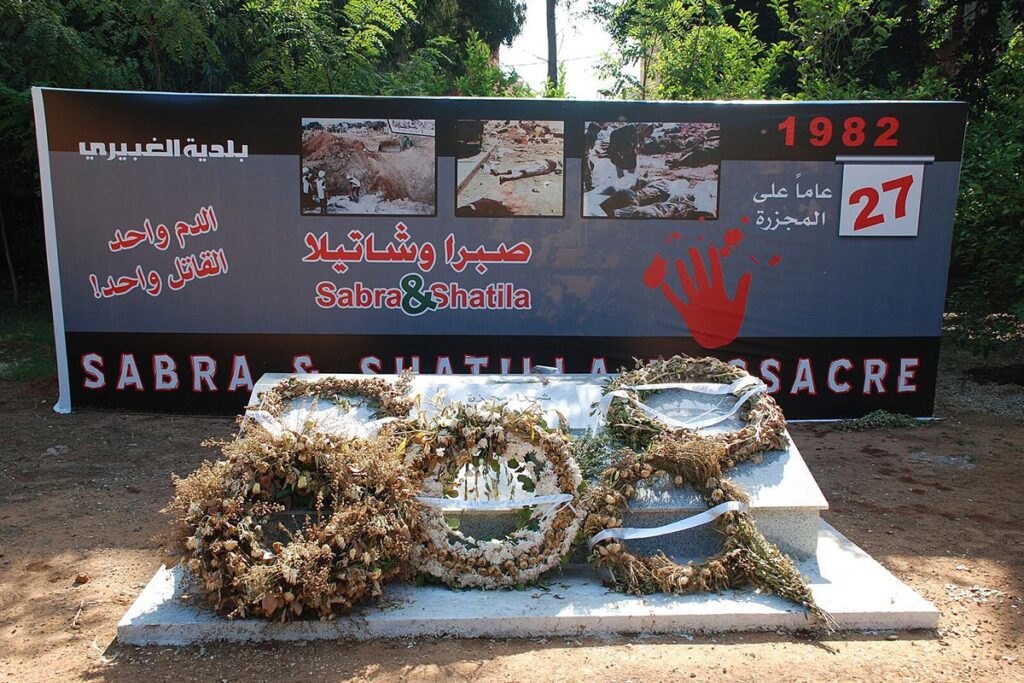Today we’re covering one of Israel’s darkest moments: Sabra and Shatila. Before we dig in, I have to tell you what I find to be one of the most fascinating aspects of human psychology.
Ever hear the expression “We see what we want to see”? That’s because our brain tricks us, showing us what we prefer to see in a given situation. It’s called desirability bias, and it can get in the way of seeing things as they actually are.
So here’s my ask. No matter how you view Israel — super positively, super negatively — pay attention to this. Because it complicates whatever narrative you have. But I think we have what it takes to tackle this head-on.
To understand the dark story of Sabra and Shatila, we’ve got to mosey on back to a groovier time: 1964. The year that the Palestine Liberation Organization, or PLO, was born. OK, maybe it wasn’t such a groovy time for Israelis. Because in 1964, the PLO was a major thorn in Israel’s side.
Today, the organization’s official website describes it as: “the embodiment of the Palestinian national movement…a broad national front, or an umbrella organization.’”
But its 1964 charter tells a different story. It denies the Jewish connection to Israel and calls for “holy war until complete and final victory has been attained…” (Yup, direct quote.) When Yasser Arafat became the PLO chairman in 1969, he took that “holy war” to the streets.
First, the PLO tried to assassinate the king of Jordan… twice. Understandably, the Jordanian king booted them out of his country. By 1971, the PLO had set up shop in southern Lebanon. They made themselves at home by setting up a state-within-a-state and terrorizing the locals. Oh, and attacking Israel.
Their most gruesome attack came in 1979. Skip ahead if you’re squeamish. Working with the Palestine Liberation Front, a Lebanese Druze teenager named Samir Kuntar crossed into Israel from South Lebanon. After murdering a police officer, Kuntar and his accomplices forced their way into the apartment that Danny Haran shared with his wife Smadar and two young daughters.
Haran helped his wife and 2-year-old into a crawl space above the bedroom. But before he could escape with their 4-year-old daughter Einat, Kuntar burst into the apartment. He forced Danny and Einat down to the beach. Kuntar made Einat watch as he shot and drowned her father. Then he smashed her head in. Meanwhile, Smadar cowered in her own home, frozen with fear. In an effort to keep the baby quiet, Smadar accidentally suffocated her.
It’s a story that could have come from Poland in 1942. The Israeli public was horrified. The next day, the IDF bombed a training base for Palestinian guerillas in Lebanon. But the PLO was undeterred, sending a barrage of rockets into northern Israel. In 1982, a shadowy PLO splinter group attacked the Israeli ambassador to England. Finally, Israeli Prime Minister Menachem Begin declared: enough is enough.
Less than 72 hours later, IDF tanks rolled into southern Lebanon. Their goal? To establish a 25-mile buffer zone between Israel and the PLO bases that were the source of so many attacks.
The IDF quickly established this buffer zone. But things got very messy, very fast.
Lebanon was already at war. Muslims fought Christians. Lebanese nativists fought the Palestinians who had flooded their country. Syria swooped in to exploit the power vacuum. Now the IDF was in the mix, hunting PLO operatives.
The enmity between the Lebanese and the Palestinians was so bad that many Lebanese were thrilled to welcome the IDF. Israel found an ally in Lebanon’s controversial Christian president-elect, Bashir Gamayel, who yearned to rid his country of foreign influence.
Hold up. If Gemayel wanted foreigners out, why did he ally with Israel? Well, Gemayel hated the PLO, who had done nothing but start trouble. He and Israel had common cause. Israeli politicians dreamed of peace with their northern neighbor.
Unfortunately, roughly 60% of the country hated Gemayel’s guts. The president-elect had survived two assassination attempts. But his luck ran out in September of 1982, when a Syrian nationalist bombed his party’s headquarters. All hell broke loose in Lebanon. And in Israel.
For the first time in Israel’s brief history, many Israelis opposed the war. We got our buffer zone! protestors cried outside of Begin’s office. We don’t want to die in Beirut! A bereaved father even wrote Begin a searing letter: “My beloved son is dead because of your war.”
Not “our war.” Your war. And the anti-war sentiment was about to swell.
Gemayel’s assassination came with serious repercussions. See, West Beirut was home to two Palestinian refugee camps: Sabra and Shatila, which the PLO used as a base of operations. The IDF had asked the Lebanese Army to rout the PLO from the camps. The Lebanese army declined. They also refused to “keep order” in West Beirut in the wake of Gemayel’s assassination. So, the IDF encircled West Beirut instead. Prime Minister Menachem Begin stated that the Israeli army was there to “keep the peace…Otherwise, there could be pogroms.”
Israel turned to Gemayel’s political party, the Phalangists, which had a paramilitary arm. The Phalangists hated the PLO. They agreed to enter the camps and find PLO fighters. The Phalangists coordinated with the IDF. They passed through IDF unit lines on their way to Sabra and Shatila. Phalangist soldiers periodically asked the IDF to fire flares over the camps. It was dark, they said. They needed the illumination from the flares in order to see. So the Israeli soldiers complied. When the Phalangists asked the Israelis to fire mortars, they did. The Israelis had faced gunfire and RPGs from the camps. They figured they were helping the Phalangists neutralize a PLO stronghold.
But something was off. A Phalangist soldier came to the intersection where the Israelis were stationed. He bragged that the militia had already killed 250 terrorists. The Israelis rolled their eyes. There’s no way those Phalangist bozos neutralized 250 terrorists in such a short amount of time, they said.
The entire world would later learn that the Phalangists were counting civilians in that death toll. Over the course of two days, the Christian militia massacred, mutilated, and raped between 800 – 2,000 Palestinian refugees. All while the IDF illuminated their way with flares, not realizing what was going on. Though there is a whole debate about that.

So it’s time for the million-dollar question: Was the massacre Israel’s fault?
Part of the Israeli public seemed to think so. Roughly 10% of Israelis flooded the streets in protest, holding signs like If I Forget Sabra and Shatila, May I Forget Jerusalem. Rabbi Yehuda Amital, the head of Yeshivat Har Etzion, condemned the massacre as “a sin not even Yom Kippur can cleanse.” But others disagreed. Prime Minister Begin summed it up bitterly: “Gentiles kill gentiles and they blame the Jews.”
And then the Israeli government did something remarkable.
It shone a light into its darkest corners, establishing the Kahan Commission of Inquiry to find out what really happened. And by February of 1983, the Commission had its verdict: though the Phalangists committed the atrocity, Defense Minister Ariel Sharon was “personally responsible.” He and IDF Chief of Staff Raffi Eitan had allowed a Christian Lebanese militia into a mostly-Muslim Palestinian camp during a civil war.
The Commission found that the Israeli government itself bore indirect responsibility for the massacre. Begin didn’t object when he learned the Phalangists were in the camps. He later claimed that no one could have predicted what the Phalangists would do. But the Commission found that less than convincing. After all, Begin himself had said the IDF was in West Beirut to “prevent pogroms.” So the Commission ruled that had he been more involved, Begin could have prevented the massacre.
The Commission acknowledged that responsibility for the atrocity lay with multiple parties. But the Phalangists and the Lebanese Army showed no interest in investigating the matter. 13 horrific massacres punctuated the Lebanese War. In 1985, Lebanese Shiites and Syrians massacred nearly 4,000 Palestinians at Shatila. Needless to say, they never established a commission of inquiry into that massacre.
Israel was the sole party with the integrity to investigate its own responsibility in a massacre. The IDF had entered Lebanon to stop the PLO’s reign of terror…and gotten horribly embroiled in a vicious sectarian war. But it was the only player in this war that was brave or ethical enough to look itself in the mirror. Even when the reflection wasn’t pretty. Because Israel is a democracy. And democracies aren’t threatened by the truth. They’re threatened by its suppression.
Let’s be clear, this is not Israel’s shining moment, but I gotta say, after Sabra and Shatila, Israel demonstrated its willingness to confront difficult moments. Ultimately, that willingness isn’t a source of weakness, but of strength. It’s what sets Israel apart. And the way I see it, it’s what makes it a light unto the other nations of the word.
